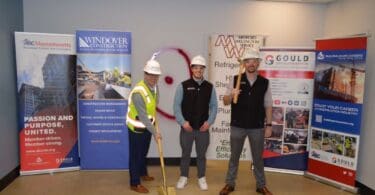I live in a great neighborhood. On my street, there are a lot of families with kids. It doesn’t matter the time of year or the kind of weather, the kids are outside. When I was a kid, my mom would tell my sister and me to “go outside and play, and don’t come home til the sun sets.” It was different then, of course, but the kids today would still rather be outside.
In the past year our necessity for being indoors, communicating via Zoom calls, has further amplified our need to connect with nature. Suddenly, we’re noticing how large that red-breasted robin is that perches on the tree outside our home office, or maybe we’re spending more time sitting quietly and listening to the sound of the trees in the wind.
It’s interesting to see that companies like Wollaston Development and SDI Architecture are responding to our need to be outside while creating a safe and healthy work environment, by designing outdoor conference rooms and meeting spaces. Could this be the new normal? Read more on page 12.
This month’s focus on Landscape Architecture and Civil Engineering also highlights how some AEC industry professionals are taking responsibility and creating solutions to problems in urban areas, such as rising sea levels. Check out the story by Cheri Ruane and John Frey of Weston & Sampson on page 15. Other firms are finding creative ways to use material, waste, land and water-use initiatives to preserve ecosystems and optimize rainwater management. Be sure to read about what’s happening with a 13-acre site at UConn Storrs on page 14.
 Nowadays, a lot of these solutions are driven by the technology that is available to our industry, technology that seems to be ever-evolving. Rapid Design Visualization (RDV) technology, for example, allows designers and engineers new ways to collaborate and communicate more effectively. Luchs, out of Connecticut, is a perfect example of a firm that is benefitting from this kind of technology. Interstate Electrical Services Corp. has long been a proponent of trying new software/technology in-house and has found ways to streamline its processes and communication. Windover Construction recently teamed with three different software companies to develop an adaptive industrial construction technique that fabricates telescopic studs from a digital model that can then be transported and adapted to any space. Read about all of these companies in our Technology & Innovation section on page 20.
Nowadays, a lot of these solutions are driven by the technology that is available to our industry, technology that seems to be ever-evolving. Rapid Design Visualization (RDV) technology, for example, allows designers and engineers new ways to collaborate and communicate more effectively. Luchs, out of Connecticut, is a perfect example of a firm that is benefitting from this kind of technology. Interstate Electrical Services Corp. has long been a proponent of trying new software/technology in-house and has found ways to streamline its processes and communication. Windover Construction recently teamed with three different software companies to develop an adaptive industrial construction technique that fabricates telescopic studs from a digital model that can then be transported and adapted to any space. Read about all of these companies in our Technology & Innovation section on page 20.
We can embrace and protect the natural world (if not save it) while utilizing technology. We just need a healthy balance. Let’s take a cue from the kids, get outside, and imagine the impossible. Only then will we see what is possible.
Anastasia Barnes











